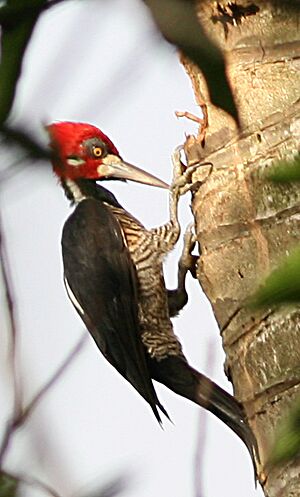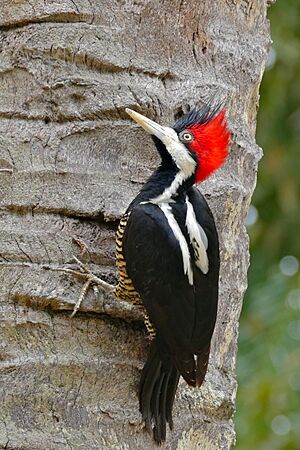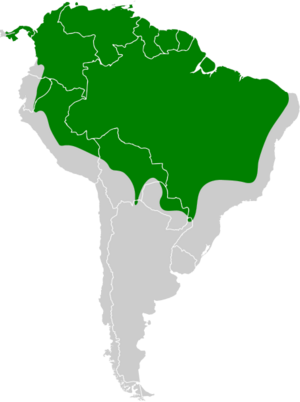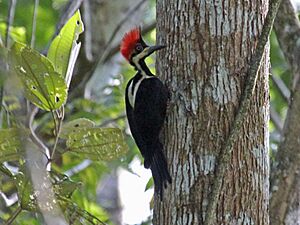Crimson-crested woodpecker facts for kids
Quick facts for kids Crimson-crested woodpecker |
|
|---|---|
 |
|
| Male | |
 |
|
| Female | |
| Conservation status | |
| Scientific classification | |
| Genus: |
Campephilus
|
| Species: |
melanoleucos
|
 |
|
The crimson-crested woodpecker (Campephilus melanoleucos) is a large and colorful bird. It belongs to the woodpecker family. You can find it in many parts of Central and South America. It lives in countries like Panama, Trinidad, and most of South America. This bird is known for its bright red crest. It uses its strong beak to find insects in trees.
Contents
What's in a Name?
The crimson-crested woodpecker got its official name in 1788. A German scientist named Johann Friedrich Gmelin named it. He called it Picus melanoleucos. The name melanoleucos comes from Ancient Greek words. Melas means "black" and leukos means "white". This refers to the bird's black and white markings.
This woodpecker is now part of the genus Campephilus. There are three types, or subspecies, of this bird:
- C. m. malherbii
- C. m. melanoleucos
- C. m. cearae
What Does it Look Like?
The crimson-crested woodpecker is a big bird. It is about 33 to 36 centimeters (13 to 14 inches) long. It weighs between 225 and 281 grams (8 to 10 ounces). It is one of the largest woodpeckers in its home range.
Both male and female birds have black upper bodies. This includes their back, wings, and tail. They have white stripes on the sides of their neck. These stripes form a "V" shape on their back. Their chest is black, and their belly is a pale, creamy color. It has wide black stripes. Their beak is long and ivory-colored. Their eyes are white or yellow.
Adult males have a mostly red head. They have a small white or yellow patch near their beak. Adult females have black around their eyes. They also have a wide white stripe from their beak down their neck. Young birds look like adult females. But young males have some red on their heads. This red is usually lighter.
One subspecies, C. m. malherbii, has a gray beak. Its underparts are also a deeper cinnamon color. Another subspecies, C. m. cearae, is smaller. It has a shorter tail than the main type.
Where Does it Live?
The main subspecies, C. m. melanoleucos, lives in many places. You can find it on Trinidad. It also lives from eastern Colombia to Venezuela. It is found in the Guianas and across most of the Amazon rainforest in Brazil. It also lives in eastern Ecuador, Peru, and northern Bolivia. You can even find it in northern Paraguay and a small part of Argentina.
The subspecies C. m. malherbii lives in Panama. It is also found in northern and central Colombia. The C. m. cearae subspecies lives in northeastern Brazil.
This woodpecker lives in many kinds of forests. It likes large, humid lowland forests. It also lives along rivers and in older re-grown forests. Sometimes, it can be found in plantations. This is true as long as there are tall trees nearby.
How Does it Behave?
What Does it Eat?
The crimson-crested woodpecker looks for food all over the forest. It often prefers the middle parts of trees. It pecks, probes, and digs into bark. It does this to find its food. Its diet is mostly insects. These include beetles, butterflies, moths, and ants. It eats both adult insects and their larvae. Some birds have been seen eating termites. They also eat small berries and seeds. This woodpecker often feeds on smaller branches. Pairs usually look for food together.
How Does it Raise its Young?
The crimson-crested woodpecker's breeding season varies. It breeds from November to January in Panama. In Suriname, it breeds from February to April. In Trinidad, it includes April, and in Colombia, February. The nesting season in other areas is not fully known.
Both male and female woodpeckers dig out the nest hole. They usually choose a large tree. They also drum and call to each other while digging. One nest was found to have two eggs. Both parents take turns sitting on the eggs. They also feed the young birds. We do not know how long the eggs take to hatch. We also do not know how long it takes for the young to leave the nest.
What Sounds Does it Make?
The crimson-crested woodpecker does not make a lot of noise. But it has different calls. During breeding season, its most common call is a "hollow, popping series of notes." It sounds like "tkep-tkep-tkep". Pairs also make calls like "kwirr kwirr-al" and "wuk wuk, wrr wrr". When they are alarmed, they make a repeated "ca-wa-rr-r" sound. They also make a shrill "put put puttas".
The bird's drumming sound is special. It starts with a strong hit. Then it has a vibrating tremble of weaker notes. It sounds like "DA-drrr". When they dig their nest, they make a steady drumming sound. Their wings also make a heavy sound when they fly.
Is it in Danger?
The IUCN (International Union for Conservation of Nature) has checked on this woodpecker. They say it is of "Least Concern". This means it is not currently in danger of disappearing. It lives across a very large area. There are more than five million adult birds. However, this number is thought to be going down.
No immediate threats have been found. But deforestation is a big problem. This is when humans cut down forests. This bird loses a lot of its home because of this. About 16.7-19.3% of its suitable forest home is lost every 15 years. Cutting down trees takes away the open, continuous forests that this bird needs to live.



